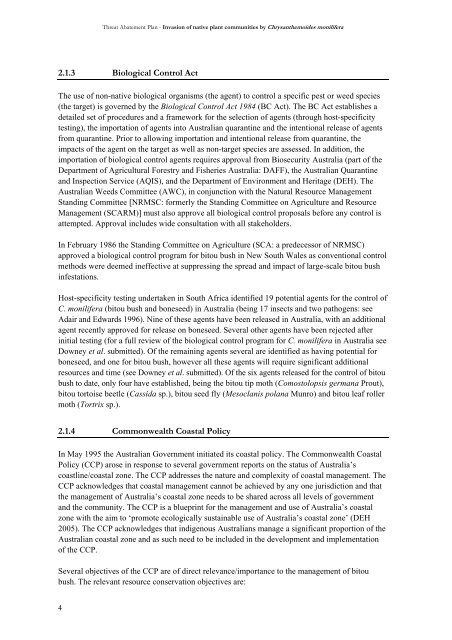NSW Bitou Bush Threat Abatement Plan - Department of ...
NSW Bitou Bush Threat Abatement Plan - Department of ...
NSW Bitou Bush Threat Abatement Plan - Department of ...
Create successful ePaper yourself
Turn your PDF publications into a flip-book with our unique Google optimized e-Paper software.
4<br />
<strong>Threat</strong> <strong>Abatement</strong> <strong>Plan</strong> - Invasion <strong>of</strong> native plant communities by Chrysanthemoides monilifera<br />
2.1.3 Biological Control Act<br />
The use <strong>of</strong> non-native biological organisms (the agent) to control a specific pest or weed species<br />
(the target) is governed by the Biological Control Act 1984 (BC Act). The BC Act establishes a<br />
detailed set <strong>of</strong> procedures and a framework for the selection <strong>of</strong> agents (through host-specificity<br />
testing), the importation <strong>of</strong> agents into Australian quarantine and the intentional release <strong>of</strong> agents<br />
from quarantine. Prior to allowing importation and intentional release from quarantine, the<br />
impacts <strong>of</strong> the agent on the target as well as non-target species are assessed. In addition, the<br />
importation <strong>of</strong> biological control agents requires approval from Biosecurity Australia (part <strong>of</strong> the<br />
<strong>Department</strong> <strong>of</strong> Agricultural Forestry and Fisheries Australia: DAFF), the Australian Quarantine<br />
and Inspection Service (AQIS), and the <strong>Department</strong> <strong>of</strong> Environment and Heritage (DEH). The<br />
Australian Weeds Committee (AWC), in conjunction with the Natural Resource Management<br />
Standing Committee [NRMSC: formerly the Standing Committee on Agriculture and Resource<br />
Management (SCARM)] must also approve all biological control proposals before any control is<br />
attempted. Approval includes wide consultation with all stakeholders.<br />
In February 1986 the Standing Committee on Agriculture (SCA: a predecessor <strong>of</strong> NRMSC)<br />
approved a biological control program for bitou bush in New South Wales as conventional control<br />
methods were deemed ineffective at suppressing the spread and impact <strong>of</strong> large-scale bitou bush<br />
infestations.<br />
Host-specificity testing undertaken in South Africa identified 19 potential agents for the control <strong>of</strong><br />
C. monilifera (bitou bush and boneseed) in Australia (being 17 insects and two pathogens: see<br />
Adair and Edwards 1996). Nine <strong>of</strong> these agents have been released in Australia, with an additional<br />
agent recently approved for release on boneseed. Several other agents have been rejected after<br />
initial testing (for a full review <strong>of</strong> the biological control program for C. monilifera in Australia see<br />
Downey et al. submitted). Of the remaining agents several are identified as having potential for<br />
boneseed, and one for bitou bush, however all these agents will require significant additional<br />
resources and time (see Downey et al. submitted). Of the six agents released for the control <strong>of</strong> bitou<br />
bush to date, only four have established, being the bitou tip moth (Comostolopsis germana Prout),<br />
bitou tortoise beetle (Cassida sp.), bitou seed fly (Mesoclanis polana Munro) and bitou leaf roller<br />
moth (Tortrix sp.).<br />
2.1.4 Commonwealth Coastal Policy<br />
In May 1995 the Australian Government initiated its coastal policy. The Commonwealth Coastal<br />
Policy (CCP) arose in response to several government reports on the status <strong>of</strong> Australia’s<br />
coastline/coastal zone. The CCP addresses the nature and complexity <strong>of</strong> coastal management. The<br />
CCP acknowledges that coastal management cannot be achieved by any one jurisdiction and that<br />
the management <strong>of</strong> Australia’s coastal zone needs to be shared across all levels <strong>of</strong> government<br />
and the community. The CCP is a blueprint for the management and use <strong>of</strong> Australia’s coastal<br />
zone with the aim to ‘promote ecologically sustainable use <strong>of</strong> Australia’s coastal zone’ (DEH<br />
2005). The CCP acknowledges that indigenous Australians manage a significant proportion <strong>of</strong> the<br />
Australian coastal zone and as such need to be included in the development and implementation<br />
<strong>of</strong> the CCP.<br />
Several objectives <strong>of</strong> the CCP are <strong>of</strong> direct relevance/importance to the management <strong>of</strong> bitou<br />
bush. The relevant resource conservation objectives are:
















